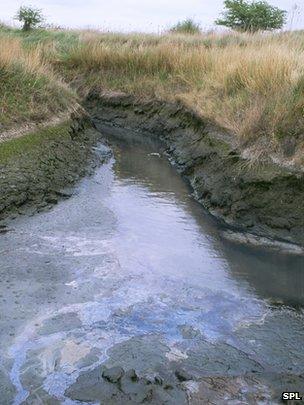'White graphene' soaks up pollutants and can be re-used
- Published

A next-generation material first earmarked for use in electronics has proven itself a capable clean-up agent for polluted waters.
Boron nitride, or "white graphene", is similar to its namesake: sheets of atoms laid out like a chain-link fence.
A report in Nature Communications shows the material can preferentially soak up organic pollutants such as industrial chemicals or engine oil.
However, it is easier to clean and re-use than other such "nanomaterials".
The family of these materials includes much-touted, carbon-based members such as graphene and nanotubes, and are notable in part for their surface area-to-weight ratio.
That allows them to take up an incredible amount for their size, making them attractive for the clean-up of pollutants.
The new work suggests that a preparation of boron nitride could outperform many nanomaterials and more traditional approaches.
A team from the Institute for Frontier Materials at Deakin University in Australia and the Pierre and Marie Curie University in France started by making porous boron nitride "nanosheets" - wavy, single-atom layers of the material with holes in them.
These porous sheets, which together form a coarse white powder, vastly outperformed sheets that did not have the pores, and commercially available chunks of boron nitride that is not made up of the tiny sheets.
The porous version exhibited high "selective absorption and adsorption" - preferentially picking up organic pollutants and dyes out of water.
The powder soaked up as much as 33 times its own weight in the chemical ethylene glycol and 29 times its own weight of engine oil. Even still, the saturated powder floats on water.
The pollutants could then be driven out of the nooks and crannies of the material by heating it in a commercial furnace, or by simply igniting it - a trick that other, more established materials could only survive a few times before becoming completely clogged up.
"All these features make these porous nanosheets suitable for a wide range of applications in water purification and treatment," the authors wrote.
Francesco Stellacci of EPFL in Switzerland called the work "an excellent paper in a booming field".
"The data reported are indeed excellent and impressive," he told BBC News. "The key question is if this is the material that at the end will be used for remediation."
Prof Stellacci said that a market for such materials does not yet exist, and boron nitride's striking clean-up powers may or may not be enough to establish it as a leading contender, even among nanomaterials.
"I think that at the end it will not be performance that will determine the final material used, but more costs and scalability. I really hope that one of these materials, and maybe this one, will make it," he said.
- Published3 January 2006